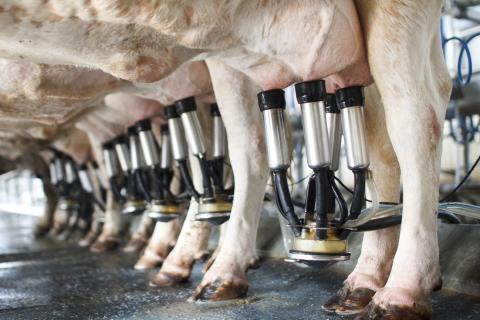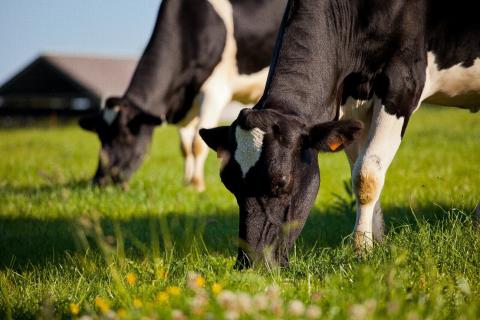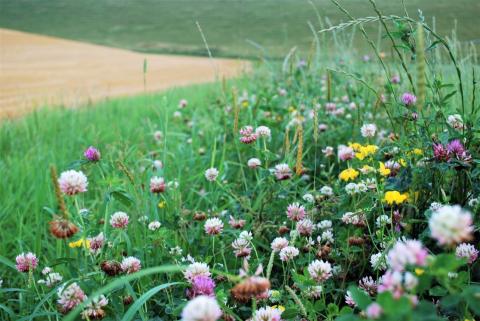15 May 2020
Dr Cate Williams: IBERS, Aberystwyth University.
- There are many advantages to a pasture-based milking system including improved product quality, increased farm profitability and reduced environmental impacts.
- The main difficulty with pasture-based milk production systems is the reduction in milk yield, especially from high yielding cows.
- Targeted supplementary feeding of high-energy concentrates to high yielding animals may help maintain milk yields.
- Diverse, mixed swards offer the potential to increase pasture protein content, improve milk fat profiles, maintain harvest yield and a multitude of environmental benefits.
As pressure is placed on farmers across the UK to improve the sustainability and environmental impact of their farming practices, many dairy farmers are considering a move to pasture and forage-based systems. One of the key difficulties of a pasture-based system is the reduction in milk yield, particularly in high-yielding cows, and sometimes a loss of body condition (Table 1). This stems from inconsistencies in the quality of grass and problems maintaining dry matter intake (DMI); even with ideal pasture conditions, grass naturally has a lower nutrient density than concentrates. However, pasture-based production systems are not without their advantages, when properly utilised, grazing can improve farm profitability, mostly through reducing bought-in feed costs (Table 1). In a pasture-based system, time and labour costs may also be reduced that would otherwise be needed to feed animals or harvest forage -making the business more profitable and sustainable. Through this mechanism, greenhouse gas emissions stemming from the import and transport of bought-in feed are significantly reduced, as well as associated issues with land-use change and deforestation in the exporting country. There is also evidence that the fatty acid profile of milk produced by grazed cows is healthier compared to those fed a total mixed ration (TMR) (Table 1).
|
Advantages |
Disadvantages |
|
Potential for milk with a health beneficial fatty acid profile |
Reduced milk yields |
|
Potential for improved sensory characteristics of milk |
Seasonal variation in grass |
|
Reduced time/labour cost |
Reduced dry matter intake |
|
Reduced environmental impacts |
Potential loss in body condition |
|
Improved welfare and expression of ‘natural’ behaviours |
|
|
Potential for improved profitability |
Table 1: Summary of the benefits and drawbacks of pasture-based dairy systems.
Changes in milk composition
The link between the ruminant diet and the resulting products is well established and can be used to produce milk and meat with specific qualities. One of the key components of milk that is easily manipulated by diet is the fat profile which is also of interest in terms of human health. In grass the human health beneficial conjugated linoleic acid (CLA) and polyunsaturated fats (PUFA) are of most interest. Grass is an excellent source of PUFA, however, because of its toxicity to the rumen microbes, they are saturated with hydrogen upon entry to the rumen. It is this action that determines the saturated fat (SFA) content of ruminant products like meat and milk. Nevertheless, if the cow is fed a good supply of PUFA a certain amount will escape the rumen and pass through to the intestine where it may be absorbed and incorporated into meat and milk. Research comparing milk from cows on a mixed diet versus pasture-fed has found significant differences in the fat profile – after transitioning to pasture, milk produced contained double the amount of CLA when compared to those fed a mixed diet. Overall, the lipid profile of milk from grazing cows is more beneficial to human health than those fed silage or a total mixed ration (TMR), containing lower levels of SFA and higher levels of PUFA. Whilst a trend towards low-fat milk and milk products has emerged, there has also been a shift in consumer interest to ‘healthier’ foods. As such, milk with a healthier fatty acid profile may have the potential to be marketed at a premium.
There is contradictory evidence for differences in milk protein content from cows fed a TMR vs. pasture fed. Some studies find that pasture-fed milk contains higher protein and casein levels, whilst others report that a grazing diet reduces protein yield. Whilst grass contains a high level of crude protein and amino acids, it is low in rapidly fermentable carbohydrates which limits the supply of energy, possibly leading to lower milk yields and protein content.
The sensory characteristics of milk-based products such as cheese and butter in relation to diet have been investigated extensively. In grazing animals, milk contains a higher proportion of PUFA and a lower proportion of SFA which makes butter softer and more spreadable. Higher levels of β-carotene are also available in fresh grass which directly translates to butter and cheese that is more yellow in colour, softer in texture and generally more preferable. Other antioxidants, such as tocopherol and carotenoids, are also more abundant in grass than in a TMR, which are associated with better stability and shelf life of milk-based products such as butter. It is said that “people eat with their eyes” which is a fairly accurate statement, as many consumers make decisions based upon the appearance of the product. Delivering a more visually appealing product, therefore, will drive consumption.
Maintaining yields
The main drawback of a pasture-based system is the reduction in milk yield, often as a result of reduced DMI. Reductions of up to 33% in milk yield have been observed in cows at pasture when compared to those housed and fed a TMR. Models predict that grazing at pasture could likely support medium-sized and moderately yielding cows, but that large or high-yielding animals may struggle to reach their full potential in terms of milk yield. Indeed, AHDB advises that up to 30 kg milk per day may be achieved on pasture alone, although higher yields require supplementation with concentrate feeds. There is also a tendency for reduced live weight gain in cows at pasture during lactation when compared to those on a TMR, likely because cows cannot eat enough additional grass to meet the increased energy demands of milk production.
Managing pasture
Particularly for high-yielding cows, it is important to maximise sward quality to maintain DMI. Ensuring consistently tall (6-8 cm), dense (≥3,000 DM/ha), highly digestible and palatable mixed swards can drive DMI up to 18 kg/day/head. To maintain good sward quality, analysis is essential – making regular assessments of sward growth and implementing a good management strategy such as rotational grazing. A good understanding of individual swards, how to manage them and regular adjustment of grazing rotation length is essential to balance supply and demand. A recent Kingshay study using high yielding spring calving cows found that it is possible to produce over 50% of milk from grass. The study maintained consistently high nutrient levels in the pasture with metabolizable energy (ME) ranging from 11.3-11.5 kg/DM and protein content at 20-26%. Only towards the end of the season, when sward dry matter fell, was supplementation necessary. DairyCo studies using autumn calving systems found that using high-quality silage doubled milk produced from forage to 70% when compared to medium quality silage. The study used an early turnout, rotational grazing system which also boosted milk from grazing and increased margins per cow substantially.
Farming Connect demonstration farm Erw Fawr is utilising new technologies to aid in their grassland management. With weekly use of a plate meter and regular input of data into a dedicated software platform, the farm aims to increase grass utilisation and yield from forage with their 250-cow all-year-round calving herd.
In addition, the Farming Connect demonstration farm, Nantglas, is also aiming to increase milk from forage by focussing on improving pasture management to maximise grazing and silage-making opportunities. Particular emphasis will be given to the silage making process to improve quality and utilisation of the silage produced.
Strategic supplementation
Strategic supplementation with a low-cost but high energy feed (e.g. grain-based, low protein) may well be sufficient to maintain high milk yields whilst grazing. Such a strategy would address the first limiting nutrient of grass, metabolisable energy, but success depends on the price relationship between milk and supplemental feed. Offering a low fibre supplementary feed helps to maintain good grass intake, whilst a higher fibre concentrate will fill the stomach and reduce the drive to graze. There is also contradictory evidence for the method of supplementation in terms of flat-rate versus feed to yield. Some studies find better productivity using the feed to yield method, whilst others observe no significant difference in any performance parameters. Regardless, studies suggest that supplementation at 0.45 kg/day is sufficient to boost milk yields and maintain grass intake as well as maintain a good profit margin when compared to lower and higher supplementation rates (0.25 and 0.65 kg/day).
Diverse swards
The second most limiting nutrient in grass is protein. To increase protein content and ME value of pasture and promote DMI, a legume or plantain may be considered. Clover (red and/or white) or plantain mixes have been proven to increase milk yields and forage intake when compared to a perennial ryegrass (PRG) monoculture. These effects vary depending on the stage in lactation – in early lactation, PRG/white clover/plantain mix caused an increase in milk volume and protein, whilst in mid-lactation an increase in milk fat was observed. When offered a diet of 25%, 50% and 75% clover pasture, DMI increased progressively by 8, 23 and 30% respectively. Daily milk yield for those grazing 50 and 75% clover was similar, at 33% higher than those grazing a PRG monoculture. This research suggests that the optimum level for inclusion of white clover in pasture is around 50%, any higher does not confer further benefits.
Studies examining cows grazed on diverse, mixed swards (containing grass, herbs and legumes) have found that the inclusion of up to nine different species did not affect milk yield. However, the changes in milk fatty acid profile described earlier are maintained on diverse pastures. Milk from cows on species-rich pasture contained higher levels of omega-3 fatty acids, which are particularly beneficial in terms of heart health and brain function. Further benefits of a mixed sward are an increase in biodiversity, enrichment of natural habitats and a reduction of nitrogen levels in the urine (in some cases by up to 20%) which in turn reduces environmental pollution. When cut, diverse swards containing 12 different species produced higher yields od dry matter (approx. 25%) compared to a species-poor sward (three different species). The persistence of the diverse sward (10 or 12 different species) was also better than the species poor one, maintaining yields throughout the four-year experiment. This increase in productivity is likely due to different species utilising different resources, which reduces competition and increases vegetation density. For this reason, increasing species richness in grasslands can also increase the density of root vegetation below the ground. This mechanism improves carbon sequestration and storage, as more carbon is introduced to the soil via the plant’s roots. This a key climate change mitigation strategy, as long-term storage of carbon in soils prevents it’s incorporation into harmful greenhouses gases such as carbon dioxide
Summary
Many scientific studies have reported that pasture-based systems of milk production have an advantage over high input, housed systems: Better sustainability, increased product quality, improved animal welfare, reduced environmental impact and better overall profitability. However, the system is not without its drawbacks, the key issue being a reduction in milk yield when compared to housed cows eating a TMR. Due to seasonal fluctuations in grass which lead to inconsistent metabolisable energy and protein content, high-yielding cows often cannot eat sufficient grass to maintain outputs. Good grassland management using rotational grazing and close monitoring of nutrient levels could be adequate to support moderate to high yielding cows. Targeted feeding of supplementary feed that is high in energy but low in protein and fibre will help to maintain milk yields whilst not affecting grass intake. Including a legume such as clover increases protein content which can help to maintain milk yields and DMI, whilst also offering environmental benefits. To further reduce environmental impacts, farmers may consider planting a species-rich, diverse sward containing herbs, legumes and grasses. These mixes offer a multitude of environmental benefits whilst maintaining excellent yields when cutting for silage and improving the fatty acid profile of milk.



